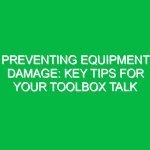Introduction
In today’s industrial landscape, ensuring Safety in potentially explosive atmospheres is paramount. This is where ATEX approval comes into play. ATEX, which stands for *ATmosphères EXplosibles*, is a European directive that outlines the necessary requirements for equipment and protective systems intended for use in environments where explosive atmospheres may occur. This directive is vital in the Health, Safety, and Environment (HSE) domain, as it aims to mitigate risks associated with flammable gases, vapors, and dust.
The significance of ATEX approval cannot be overstated. It serves as a benchmark for Safety, ensuring that the equipment used in hazardous locations meets stringent safety Standards. By adhering to ATEX guidelines, industries not only comply with regulatory requirements but also foster a culture of safety that protects employees and the environment.
Understanding ATEX Approval in the HSE Context
What is ATEX Approval?
ATEX approval is a certification that indicates equipment is safe to use in explosive atmospheres. There are two main directives under ATEX:
- ATEX 114: This directive focuses on equipment and protective systems intended for use in potentially explosive atmospheres.
- ATEX 153: This directive applies to workplaces where explosive atmospheres may be present, detailing the responsibilities of employers in terms of Safety Measures.
Equipment that receives ATEX approval is tested and certified to ensure it does not ignite an explosive atmosphere. This process involves rigorous assessments and testing Procedures to confirm compliance with the relevant standards.
The Importance of HSE Guidelines in ATEX Approval
In the context of HSE, ATEX approval plays a critical role in establishing a framework for safety. Health, safety, and environmental practices are integrated into the design, manufacturing, and operational processes of equipment used in Hazardous Areas. This integration ensures that safety is a priority at every stage, from conception to execution.
Moreover, ATEX guidelines require regular risk assessments and the implementation of preventive measures to minimize potential Hazards. By following these guidelines, organizations can significantly reduce the likelihood of accidents, protect their workforce, and maintain environmental integrity.
Key Aspects of ATEX Approval Relevant to HSE
Risk Assessment and Hazard Analysis
One of the foundational steps in achieving ATEX approval is conducting a thorough risk assessment. This process involves identifying potential Hazards associated with explosive atmospheres, evaluating the risks, and implementing Control Measures to mitigate them.
Real-world scenarios often highlight the importance of this step. For instance, a chemical manufacturing plant might identify that certain chemicals, when mixed, create explosive vapors. By recognizing this risk, the facility can implement controls such as ventilation systems and explosion-proof equipment, ensuring compliance with ATEX standards.
Equipment Classification and Selection
Understanding equipment classification is crucial for ATEX approval. Equipment is categorized based on its intended use and the type of explosive atmosphere it may encounter. The classification system includes:
- Zone 0: Areas where explosive atmospheres are present continuously or for long periods.
- Zone 1: Areas where explosive atmospheres are likely to occur in normal Operation.
- Zone 2: Areas where explosive atmospheres are not likely to occur in normal operation.
Selecting the right equipment for these zones is vital. For example, using a standard electrical motor in a Zone 0 area could lead to catastrophic results. Instead, an ATEX-approved motor designed for that environment should be employed.
Maintenance and Inspection Protocols
Ongoing Maintenance and regular inspections of ATEX-approved equipment are essential to ensure continued compliance and safety. Organizations must establish maintenance schedules that include:
- Routine inspections to identify wear and tear.
- Testing safety features and fail-safes.
- Documenting maintenance activities for compliance verification.
In a practical case, a refinery that failed to maintain its ATEX-approved pumps experienced a failure that led to an explosion. This incident underscores the necessity of rigorous maintenance protocols to uphold safety standards.
Training and Competence
Equipping employees with knowledge and skills related to ATEX Regulations is another crucial element of HSE compliance. Training programs should cover:
- The principles of explosive atmospheres.
- Safe operational practices for using ATEX-approved equipment.
- Emergency response procedures in case of a hazardous event.
For instance, a Training session that involves simulated scenarios can significantly enhance employees’ understanding of handling equipment in explosive environments. Such proactive measures can save lives and prevent accidents.
Regulations and Standards Governing ATEX Approval
European Directives
ATEX approval is governed by several European directives beyond the main ATEX directives. Key regulations include:
- The Machinery Directive (2006/42/EC), which outlines safety requirements for machinery.
- The Low Voltage Directive (2014/35/EU), ensuring electrical equipment operates safely.
- The EMC Directive (2014/30/EU), addressing electromagnetic compatibility.
Compliance with these regulations is essential for maintaining ATEX approval. Organizations must remain updated on these directives to ensure their equipment and practices align with legal requirements.
The Role of Notified Bodies
Notified Bodies are organizations designated by EU member states to assess compliance with ATEX directives. They conduct audits, testing, and evaluations to provide ATEX certification. Selecting a reputable Notified Body is critical, as their expertise can significantly influence the approval process.
Conclusion
In conclusion, unlocking ATEX approval is a multifaceted process that requires a thorough understanding of health, safety, and environmental guidelines. By focusing on risk assessment, equipment classification, maintenance, and employee training, organizations can create a robust safety culture that not only complies with ATEX standards but also protects their workforce and the environment.
ATEX approval is not merely a regulatory checkbox; it is a commitment to safety and Sustainability. Industries must prioritize these guidelines to prevent accidents and foster a safer working environment. As regulations evolve, continuous education and adaptation will be vital in maintaining compliance and achieving safety success in potentially explosive atmospheres.


